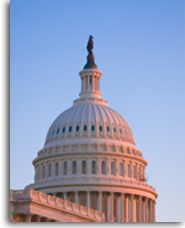A key Democratic messaging point is well-expressed in Margot Sanger-Katz’s “Republicans Say They Will Protect Pre-existing Conditions. Their Records Say Something Else” at The Upshot. As Sanger-Katz explains, “It is Democrats, by passing the Affordable Care Act in 2010, who introduced meaningful protections for Americans with prior illnesses…And Republican officeholders have taken numerous actions that would tend to weaken those protections — in Congress, in states and in courts. The Trump administration introduced a sweeping new policy just last week that would allow states to sidestep Obamacare’s requirement to cover pre-existing conditions…Pre-existing conditions have been a central theme in Democratic campaigns around the country.” The rest of the article rolls out the shameful GOP record of trying to gut previous illness protection. Not a bad message to amplify in the last full day of the 2018 miderm campaign.
From “What Americans care about ahead of the 2018 elections, mapped” by Andrew Van Dam at Wonkblog:

The Google searches map above supports the argument that most Democratic House candidates in districts in counties not colored green don’t need to say much about the so-called ‘caravan’ before the election. Dems running in districts in those green counties will have to address the immigration issue in some way, but may be able to avoid Trump’s caravan hysteria as the campaigns close, since even those districts likely have lots of voters more concerned with health care costs and GOP threats to Social Security. In any event, Dems will have to tackle the immigration issue with more credible policies after the election, when there is more time to do it justice. As New York Times reporter Brett Stephens argues, Democrats are going to have to come up with a more credible immigration policy than simply calling for more compassion, or abolishing ICE. Many Dems do so, but the party needs to unify on the issue as much as possble, hone their case and get on message.
I disagree, however, with one of the main points in Stephens’s NYT column, “Why Aren’t Democrats Walking Away With the Midterms?” — that the main reason there won’t be a blue tsunami is Democratic incompetence and naivete. In reality, the Senate map is just too brutal this year, and Stephens also undervalues the sheer power of incumbency and gerrymandering. But Stephens has a couple of insightful nuggets tucked in his column, and Dems ought to take them seriously: “Because the president’s critics tend to be educated and educated people tend to think that the only kind of smarts worth having is the kind they possess — superior powers of articulation combined with deep stores of knowledge — those critics generally assume the latter…There’s more than one type of intelligence. Trump’s is feral. It strikes fast. It knows where to sink the fang into the vein.” Also, “The secret of Trump’s politics is to mix fear and confidence — the threat of disaster and the promise of protection — like salt and sugar, simultaneously stimulating and satisfying an insatiable appetite. It’s how all demagogues work…Democrats should be walking away with the midterms. That they are not is because they have consistently underestimated the president’s political gifts…”
Dems gotta like the Politico headline, “‘Trump has hijacked the election’: House Republicans in panic mode: Worries deepen that Trump’s charged immigration rhetoric will cost the GOP more seats.” In the article, Rachael Bade, Carla Marinucci and Elana Schor explain, “Two days out from an expected Democratic takeover of the House, Republicans focused on the chamber are profoundly worried that Trump’s obsession with all things immigration will exacerbate their losses. Many of these same Republicans welcomed Trump’s initial talk about the migrant caravan and border security two weeks ago, hoping it would gin up the GOP base in some at-risk, Republican-held districts…But they now fear Trump went overboard — and that it could cost them dearly in key suburban districts, from Illinois to Texas. Many of them have cringed at Trump’s threats to unilaterally end birthright citizenship, as well as his recent racially-tinged ad suggesting that immigrants are police killers…“His honing in on this message is going to cost us seats,” said one senior House GOP campaign source. “The people we need to win in these swing districts that will determine the majority, it’s not the Trump base; it’s suburban women, or people who voted for [Hillary] Clinton or people who are not hard Trump voters.”
In his National Journal article, “A Late Nudge Toward Democrats? Events of the last week, particularly the tragedy in Pittsburgh, seem to have tipped electoral momentum away from Republicans,” Charlie Cook writes that “it’s hard to be thinking about a strong economy and declining unemployment when we have pipe bombs being mailed to Democratic leaders, an anti-Semite shooting up a synagogue, and a racist trying to break into an African-American church but instead shooting people in a Kroger…it seems like we are seeing a bit of a movement back toward Democrats in public and private surveys…it seems really likely that Democrats pick up at least 20 and maybe as many as 50 seats in the House, with a 30-40 range most plausible. If I had to hang it on a single number, let’s call it a 35-seat gain for Democrats at the top of the curve. It’s not so much whether the overall turnout is high or low—and it does look like we may have a modern-record-level turnout for a midterm election—but which groups disproportionately vote that is the key and unknowable factor at this stage.”
“The significance on Capitol Hill would be House Democrats being able to schedule floor action and to a certain extent frame the policy debate, wield the gavel in committees and, of course, call oversight hearings and subpoena witnesses and documents,” Cook continues. However, “It is in the states where there is the potential for real policy changes…We could see Democrats plausibly gaining anywhere from four to 10 net governorships, with a six-to-eight-seat gain most likely, some in some pretty key states. It would be equally plausible for Democrats to gain somewhere between 400 and 600 state legislative seats, potentially tipping between five and 11 state legislative chambers…” Also check out the charts for GA and TX at Tom Bonier’s “Early Vote Data Shows Young and Non-White Voter Turnout Surge,” which are very encouraging.
Hollywood endorsements of candidates are generally worthless. But the nonpartisan Hollywood ‘telethon’ sponsored by ‘We Are the Vote’ that will be streamed live tonight YouTube, Facebook Live and Comedy Central’s website urging young people to vote may prove helpful. As reported by Reuters, “In a first-of-its-kind event, more than 50 actors, comedians and YouTube stars will join a two-hour, live-streamed telethon on Monday night aimed at firing up younger voters, the age group least likely to cast a ballot…Stars will not ask for money during the “Telethon for America.” Instead, they will urge viewers to call in to a celebrity phone bank and pledge to vote the next day…Reuters polling found that in October only 25 percent of people aged 18 to 29 said they were certain to vote in the election, the lowest percentage of any age bracket.” It’s a commendable project, but including some top musicians and pro athletes who may have more influence with young people than actors, could be a plus in future projects.









